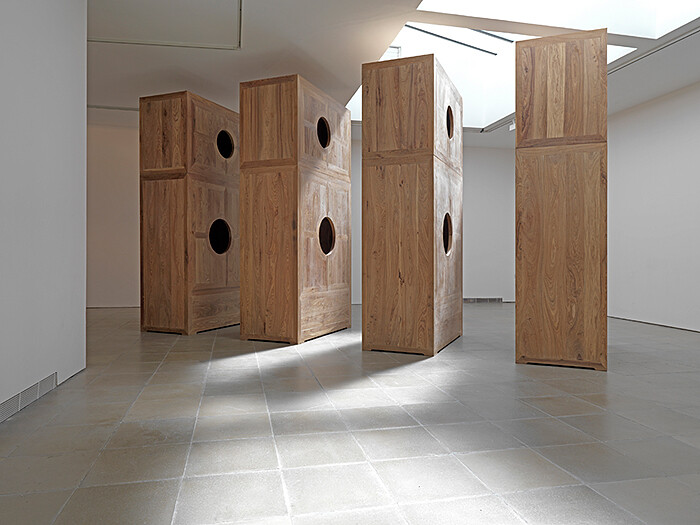Be it tax evasion or political activism with excessive media, or the former that makes the perfect bait for the latter, it will be hard to tell. What is certain is that artist Ai Weiwei was released on bail by the Chinese police after being arrested and detained without access to his lawyer for some eighty days.
Under these circumstances, what can be said about another exhibition of Ai Weiwei that does not risk turning recent reactions to the artist’s arrest into banal manoeuvres deprived of potency to incite action? Can we ask this of ourselves without sounding cynical?
It is a delicate situation, and we are well aware that the recent exhibitions of Ai Weiwei’s work no doubt solidified his relevance as an artist; even so, a rather disenchanted perspective hovers over recent events, which could be perceived as a shadow of opportunism trailing the increase of interest in the artist.
Ai Weiwei was omnipresent during the opening of the Venice Biennial: one of the texts of its official catalogue bears the title “Where is Ai Weiwei”—a diffuse slogan which has become a mute motto to reaffirm the pressure for justice. And words were not the only weapon, as many wore a sticker portraying the face of Ai Weiwei. Red and black (and vaguely resembling the iconic representation of Che Guevara) the sticker morphed the artist’s well-known resistance into a phenomena of cultural industry that is exchanged, bought, worn and appropriated by anyone—all the while, in effect, cancelling the power of what is being transmitted.
Amidst this context, Lisson Gallery’s exhibition presents an overview of some key works in Ai Weiwei’s career. Its preparation was interrupted when the artist was arrested, which might explain the lack of homogeneity of the show, more of a selection of well-displayed single pieces than an articulated exhibition. But the show still manages to propose a balance between different bodies of work, suggesting how the artist moves between irreverence and delicacy.
Delicacy is certainly present in Moon Chests (2008), by far the best piece of the exhibition: a set of three-meter high, minimal wood cases perforated with two large holes on each side. Made from huali wood, often used in Chinese furniture, and constructed with an ancient technique that uses no additional joining materials, they were executed so as to produce eighty variations mimicking the phases of a lunar eclipse. Incredibly light and beautiful, they create suspension and silence, inducing light and shadow to swap roles according to the viewer’s perspective.
If these crates pay tribute to the obscurity of the earth’s celestial body, the rest of the exhibition pursues reflections upon the role of memorials, with a stronger tone. If the value of the monument has been systematically questioned and defied of late, this show is yet another provocation to their function, particularly targeted to the exhaustive use of memorial structures to reinforce official state discourses.
Ai Weiwei creates a strategy of defiance of the status (symbol, value, function) of monuments that functions like an autoimmune deficiency: in presenting monument-like elements the artist undermines the very essence of commemorative structures, imploding their significance. His perfect marble replica of a CCTV surveillance camera (Surveillance Camera, 2010), similar to those positioned by the authorities outside his studio, is certainly a sharp play on the artist’s capacity to turn a functional object into a stone and, likewise, create a monument denouncing state measures of control and paranoia.
Coloured Vases (2009-10) is a grouping of original Han Dynasty pots from between 200BC-220AD that the artist covered with bright industrial pigments. With such a simple yet profane gesture towards these objects, which have managed to survive the mercilessness of time, the artist has turned them into vivid reminders of the massive destruction of civilization during the Cultural Revolution. Likewise, their symbolic function takes on new hues when they become pop art ready-made commodity goods.
But truly extending the regime of profanity is the Coffin (2005), a more disturbing exchange of function and aura; not only because it is an object constructed with wood from dismantled temples of the Qing Dynasty (1644-1911), but also because it adapts a casket into a scriptorium table surrounded by two long benches where people can sit, work, and sleep—completely ignoring the funerary apparatus.
Nearby is a presentation of a selection of the artist’s videos that includes Chang’an Boulevard (2004), a 10-hour video portrait of Beijing’s central location for official parades, a place also associated with the Tiananmen Square protests of 1989. Observing this serene street, with its construction sites, office buildings, and passers-by, it is hard to picture that this might have been the street where an artist was abducted from society without anyone knowing his whereabouts for days on end.
Though reflecting on how the glory of ancient knowledge and wisdom can easily co-habit with naked brutality and arrogance, this show nonetheless remains in a mute dialogue between an individual and the power structures that reign. But none of this solves the initial problem. To the contrary, this text follows an identical wake of celebratory and militant gestures of solidarity with Ai Weiwei’s ordeal, gestures whose effectiveness will hardly ever be attested. While a proposition that might resolve such a contradiction has yet to be found, another question arises: did the same irreverent power of Ai Weiwei’s work that imprisoned him contribute to setting him free?






